-
You are here:
Home
›
-
Food in South Africa
›
-
Pot food
The Magic of pot food ("Potjiekos")
in South Africa
"Potjiekos" (literally meaning pot food) has been
part of South Africa’s culture for many centuries. When the first Dutch settlers arrived in the
Cape, they brought with them their ways of cooking food in heavy cast iron pots, which hung from
the kitchen hearth above the fire.
Long before the arrival of the early settlers in the Cape, the Bantu people who were migrating
into SouthAfrica, learned the use of the cast iron cooking pot from Arab traders and later the
Portuguese colonists.
These cast iron pots were able to retain heat well and only a few coals were needed to keep the
food simmering for hours.
They were used to cook tender roasts and stews, allowing steam to circulate inside instead of
escaping through the lid.
The ingredients were relatively simple, a fatty piece of meat, a fewpotatoes and some vegetables
were all that was needed to cook a delightful meal.
The round potbellied cast iron pot was the perfect cooking utensil to suit the nomadic lifestyle
of the black tribes and the Voortrekkers during the 17th and 18th centuries.
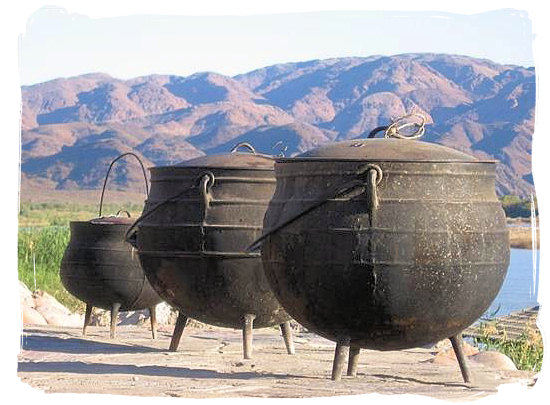
Cast iron pots
pot food ("Potjiekos") in South Africa
"Potjiekos" evolved as a stew, made ofvenison and vegetables (if the latter were available). The
pot with its contents protected by a layer of fat was hooked under the wagon by the Voortrekkers
while travelling and unhooked at the next stop to be put on the fire again.
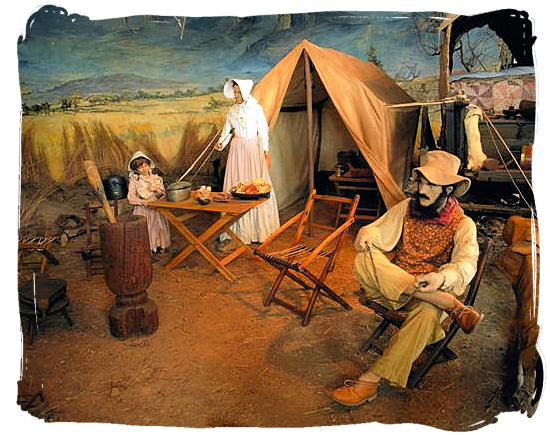
Nomadic lifestyle of the "Voortrekker" families during the 17th and 18th centuries
pot food ("Potjiekos") in South Africa - copyright © South African tourism
When the wagons stopped at the end of the day and camp was made, game was stewed and sometimes mutton ,
goat or old oxen when available. As each new animal was shot, it was slaughtered and the meat added to the
pot, together with whatever vegetables that could be found. The large bones were added replacing the old
ones, to thicken the stew. Surplus meat was preserved by seasoning and drying.
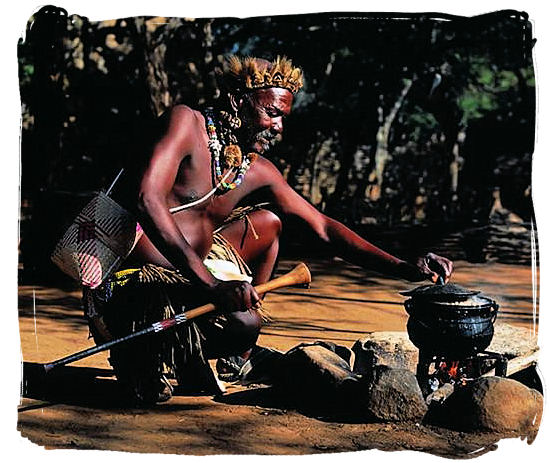
The perfect cooking utensil to suit the nomadic lifestyle of the black tribes
pot food ("Potjiekos") in South Africa - copyright © South African tourism
Today, cooking up a "potjie" has evolved into a unique South African social happening, a tradition almost as
popular as the legendary "Braai" (barbecue). Family and friends are invited and they all settle around the
fire with the softly bubbling "Potjie", chatting, enjoying a drink and having a great time, while the
aroma escaping from the "potjie", does its work.
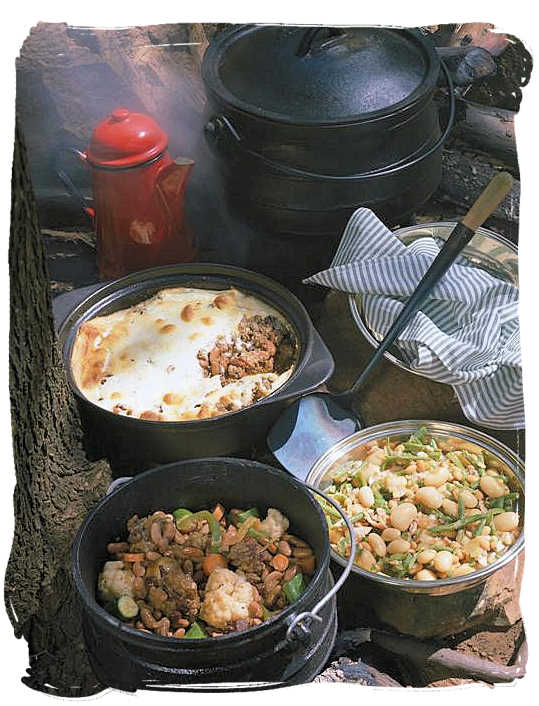
South Africa’s "potjie" tradition is almost as popular as the legendary "Braai" (barbecue)
pot food ("Potjiekos") in South Africa - copyright © South African tourism
The range of different recipes is as wide as the imagination stretches and every "potjie" expert has his or
her own secrets and special recipes. The best meat to use for "potjiekos" is what is known as stewing beef,
sinewy and gelatinous cuts of beef which become deliciously tender when simmered for a long time,
developing a strong meaty flavour. Other meat such as venison, mutton, chicken and even fish make ideal
"potjies".
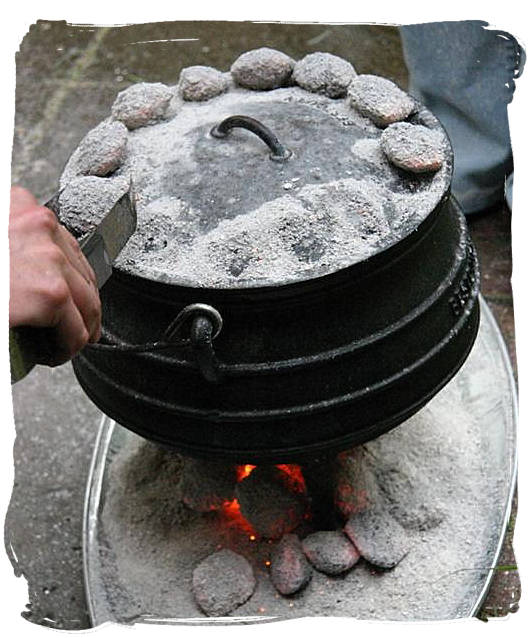
Simmering "potjie"
pot food ("Potjiekos") in South Africa
The fire is an important part of creating a culinary "potjie" masterpiece. Unlike a "braai", the choice of
wood or charcoal does not make much difference, as long as you can regulate the heat. That is done by
adding or removing coals once the "potjie" is heated up.
You only need a few to keep the "potjie" simmering. A good idea is to keep a separate fire going to provide
the necessary coals. Keep in mind to season or "cook-in" a new "potjie" to get rid of any iron filings and
other unwanted residue.
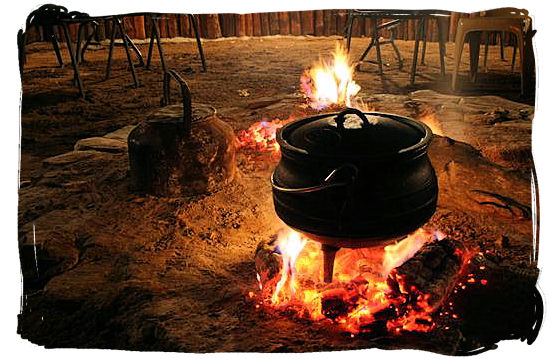
Heating up the "potjie"
pot food ("Potjiekos") in South Africa
The packing of the food in layers is the other important part. The meat usually comes first. Add a dash of
cooking oil or some fat in the pot, add meat the meat and brown thoroughly. This is essential to seal-in
the flavour and improve the appearance of the meat.
Cook the meat till nearly done. Add onions, garlic, herbs and spices and sauté. Finally add a little red
wine or some meat stock, only a small amount of liquid is needed and stir. Most important, do not stir again
until the food is ready to be served.
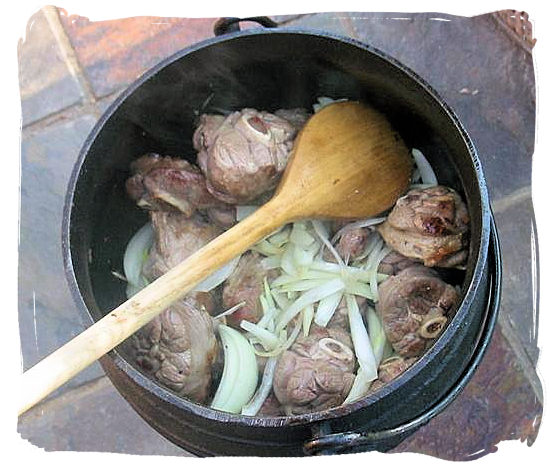
The meat is usually the first layer in the "potjie"
pot food ("Potjiekos") in South Africa
Now pack in the layers of vegetables in order of their cooking times, like carrots and potatoes first and
thereafter sweet potatoes, pumpkin, mushrooms etc. Add liquid until about 2 cm under the top layer of
vegetables and just leave it for a couple of hours until ready. Add a little liquid when the food tends
to cook dry, but only a little at a time as watery "potjie" is not nice and too much flavour is lost.
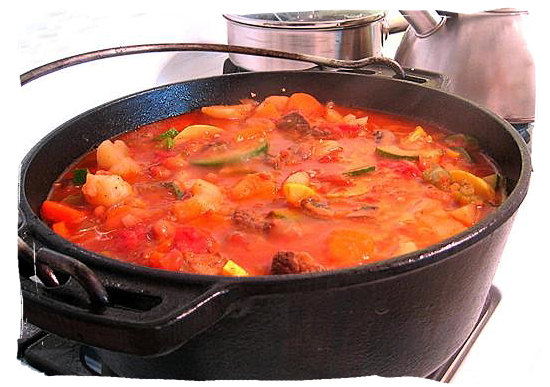
Dish up and enjoy a memorable meal
pot food ("Potjiekos") in South Africa
When ready, stir once to ensure an even mix of meat and vegetables, dish up and enjoy a memorable meal.
After the meal, rinse the pot with warm water only and then just rub it dry. In the process the residue of
fat from the meal will coat the inside and protect it from rusting. If necessary, use a little oil or fat.
With time and usage the "potjie" will become smooth and shiny on the inside, a companion for life.
Top of Page
-
Home
›
-
Food in South Africa
›
-
Pot food

